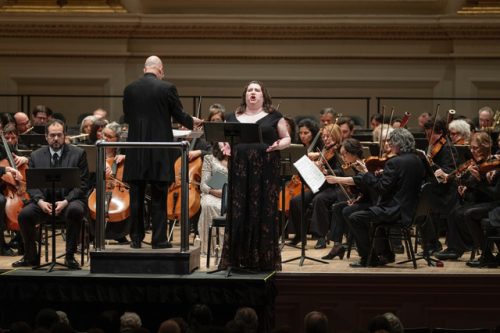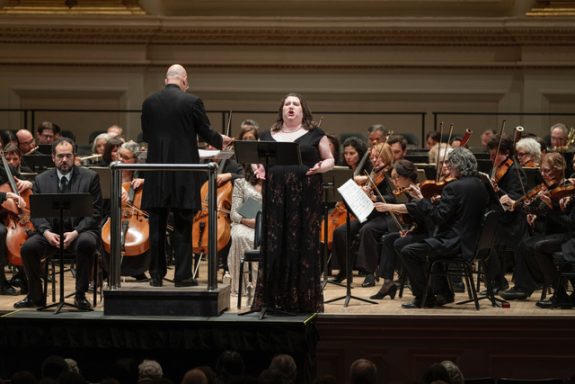 United States Schoenberg, Gurre-Lieder: Soloists, Bard Festival Chorale, American Symphony Orchestra / Leon Botstein (conductor). Carnegie Hall, New York, 22.3.2024. (RP)
United States Schoenberg, Gurre-Lieder: Soloists, Bard Festival Chorale, American Symphony Orchestra / Leon Botstein (conductor). Carnegie Hall, New York, 22.3.2024. (RP)

Cast:
Waldemar – Dominic Armstrong
Tove – Felicia Moore
Wood Dove – Krysty Swann
Farmer – Alan Held
Klaus the Jester – Brenton Ryan
Narrator – Carsten Wittmoser
It takes audacity to conceive and compose a work as monumental as Gurre-Lieder, and Arnold Schoenberg was such a person. In the remarkably well-attended, highly informative and entertaining pre-concert introduction, Leon Botstein actually used the word megalomaniac. He may well have been describing himself to a certain degree as that quality is what it takes to conduct such a work.
Botstein assured those gathered that this is not the Schoenberg who has frightened generations of concertgoers at the mere mention of his name. Rather, Gurre-Lieder is a young, evolving composer’s self-constructed monument to his place in the pantheon of German masters stretching from Bach to Wagner. Schoenberg may have drastically changed course stylistically, but he always viewed himself as carrying that torch forward.
The music that Schoenberg composed for the massive oratorio is in the vein of Mahler and late Richard Strauss. Wagner’s spirit pervades Gurre-Lieder too, especially in Schoenberg’s use of musical themes to depict characters and plot elements. No wonder that Mahler and Strauss, as well as Alexander von Zemlinsky, Schoenberg’s teacher, encouraged the young composer. He was a chip off the old block.
It is the gargantuan scale of forces that Schoenberg employed which makes Gurre-Lieder such a daunting undertaking. He calls for five soloists, a narrator, three male choruses of four parts each, an eight-part mixed chorus and an orchestra of about 150. For this performance, Botstein employed the requisite four harps, four piccolo, seven clarinets, twelve E-flat clarinets, eleven horns, four Wagner tubas, and an out-sized percussion section that included ratchets and large iron chains.
The medieval Danish legend that inspired Schoenberg is based loosely on historical facts as retold by Jens Peter Jacobsen, a nineteenth-century Danish poet. Schoenberg arranged the tale in three sections, the first of which tells of King Waldemar’s love for Tove, the beautiful maiden who is poisoned by his jealous wife.
In the second part, Waldemar rails against God for permitting such an act. It goes on to relate the fate of Waldemar and his men who are doomed to ride each night on a terrifying hunt for such blasphemy. The work concludes with the coming of spring and the dawn of a new day, as Waldemar and Tove are united and the chorus sings of the glories of the rising sun.
A heldentenor is required to do full justice to Schoenberg’s music for Waldemar, and Dominic Armstrong is not one. He sang with style, elegance and particular attention to text, but his voice could not ride the torrents of sound that Botstein unleashed from the orchestra. In calmer numbers, such as the song where Waldemar senses Tove’s presence in the beauty of nature, Armstrong’s voice could be heard and the emotions which it conveyed felt.

Felicia Moore’s soprano is cut from the vocal cloth that gets a Wagnerian’s pulse racing. Her resplendent voice soared effortlessly over the massive orchestra at any volume. In Tove’s final song where she rhapsodizes on death, Moore’s voice was radiant as she sang of a final ecstatic kiss. Her glorious sound, together with sparkling playing from the orchestra and complete with cascades of swirls from the harps, made it the most magical moment of the performance.
The orchestral textures thin for the ‘Wood Dove’s Song’, which permitted mezzo-soprano Krysty Swann’s dusky voice to be heard effortlessly. She instilled the story of Tove’s death and Waldemar’s grief with a dramatic flair that amplified the mystery and sorrow surrounding the lovers’ fate.
To the accompaniment of some wonderful, spine-chilling music, veteran bass-baritone Alan Held conjured the thrills and horrors of Waldemar and his vassals riding through the night sky. As Klaus the Fool, Brenton Ryan made his entrance through the audience, lithely sliding onto the stage. He gave a winning and biting performance of the only bit of humor in the work, in which Klaus bemoans his fate of being forced to ride with the king at night, rather than being left to enjoy what few pleasures were afforded him in life
The work ends with a long narrative passage that Schoenberg called a ‘Melodrama’ in which he employed the vocal technique of ‘Sprechstimme’. Bass-baritone Carsten Wittmoser exhibited a calculated sense of sophistication as he etched each word with precision and clarity. It is undoubtedly the most bewildering musical passage in the work, but it was as fascinating as it was odd.
The orchestra reveled in Schoenberg’s colorful and dramatic score. Botstein was sensitive to dynamics, if not always balance. There was often a muddiness to the orchestral sound when transparency and lightness were needed. Schoenberg called for 200 singers, so it came as no surprise that the hundred or so in the Bard Festival Chorale struggled to be heard over the enormous orchestra.
The ASO has a connection with Gurre-Lieder that extends back in time to its 1932 US premiere by The Philadelphia Orchestra under Leopold Stokowski. The British-born American would go on to found the ASO in 1962. Then as now, its mission was to demystify orchestral music, especially in less-often heard works on the fringes of the popular repertoire like Gurre-Lieder, and to make it accessible and affordable.
Botstein and the ASO have stayed true to that creed. The resounding ovation from the near-capacity audience after the glorious music that concludes Gurre-Lieder demonstrated how much their efforts and dedication are valued.
Rick Perdian
